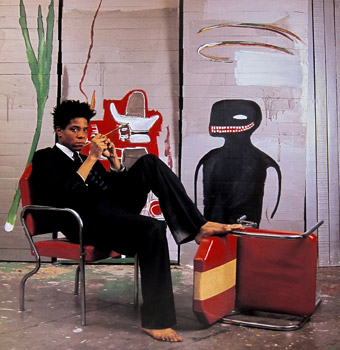Basquiat
15 October 2010 – 30 January 2011
11 Avenue du Président Wilson
75116 Paris
Of mixed Puerto Rican and Haitian descent, Basquiat was born in Brooklyn in 1960 and died of a drug overdose in New York in 1988, aged twenty-seven. He was part of the generation of graffiti artists who burst onto the New York scene in the late 1970s.
In 1977, he began signing his graffiti “SAMO”—for “Same Old Shit”—with the addition of a crown and the copyright symbol ©. In the course of a dazzling career, his work moved from street art to painting, offering a mix of Voodoo and Biblical mythologies, comic strips, advertising and the media, African-American music and boxing heroes and assertion of his negritude. Thus he defined an underground urban counterculture at once violently anarchistic and seething with liberty and vitality. In 1982, Basquiat was invited to Documenta 7 in Kassel, Germany, and in the following year he became the youngest artist—and the first black one—ever to show at the Whitney Biennial in New York. In 1984, he began co-creating paintings with Andy Warhol, continuing until the latter’s death in 1987.
At the time, Conceptualism and Minimalism were the austerely dominant avant-garde currents in American art. Basquiat’s coming brought a break with this trend and saw him become the star of the “Neo-Expressionist” wave. This unexpected revival of a painting espousing innocence and spontaneity, deliberate lack of skill and unrestrained use of violent figuration lasted until the early 1980s.
Basquiat had always described himself as influenced by his everyday urban environment, and the roots of his “primitivist expressionist” practice are to be found in the postwar European painting of Jean Dubuffet—refractory to “stifling culture”—and Cobra, as well as the great American tradition extending from Robert Rauschenberg to Cy Twombly. His premature death in 1988 left behind it a substantial oeuvre pervaded by death, racism and his personal fate. With its mix of star-system and revolt, his explosive, incendiary life was the inspiration for Basquiat, directed by filmmaker-painter Julian Schnabel in 1996.
In 1984, the Musée d’Art moderne de la Ville de Paris presented Jean-Michel Basquiat in the group exhibition “Free Figuration France/USA”, in which his work appeared alongside of that of Robert Combas, Hervé Di Rosa and Keith Haring.
Comprising a hundred major pieces—paintings, drawings, objects—from numerous museums and private collections in the United States and Europe, this retrospective will allow the viewer a chronological overview of the career and the chance to assess Basquiat’s importance to art and art history in the post-80s years.
The first exhibition on this scale ever devoted to this artist, “Basquiat” has been designed by the Beyeler Foundation and organized in conjunction with the Musée d’Art moderne de la Ville de Paris. It will come to Paris after showing at the Beyeler Foundation in Basel from 9 May – 5 September 2010.
The exhibition will be accompanied by a catalogue published by Editions Paris Musées (256 pages).
Chief curator
Fabrice Hergott
Curators
Dieter Buchhart
Marie-Sophie Carron de la Carrière
Practical information
Musée d’Art moderne de la Ville de Paris
11 Avenue du Président Wilson
75116 Paris
Tel. 01 53 67 40 00
www.mam.paris.fr
Open Tuesday–Sunday, 10am – 6pm
Late night opening Thursday 10pm
Press officer
Maud Ohana
Tel. 01 53 67 40 51
Email: maud.ohana@paris.fr
*Image above:
Private collection.
Photo © Lizzie Himmel.
© The Estate of Jean-Michel Basquiat.
© ADAGP, Paris 2010

